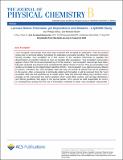Files in this item
Laccase redox potentials: pH dependence and mutants, a QM/MM study
Item metadata
| dc.contributor.author | Goetze, Jan Philipp | |
| dc.contributor.author | Buehl, Michael | |
| dc.date.accessioned | 2017-08-17T23:33:02Z | |
| dc.date.available | 2017-08-17T23:33:02Z | |
| dc.date.issued | 2016-09-08 | |
| dc.identifier | 245112100 | |
| dc.identifier | 49bb75f3-d5fb-4bd8-9702-0c94fd5f49d0 | |
| dc.identifier | 84986270048 | |
| dc.identifier | 000383005200001 | |
| dc.identifier.citation | Goetze , J P & Buehl , M 2016 , ' Laccase redox potentials: pH dependence and mutants, a QM/MM study ' , Journal of Physical Chemistry B , vol. 120 , no. 35 , pp. 9265-9276 . https://doi.org/10.1021/acs.jpcb.6b04978 | en |
| dc.identifier.issn | 1520-6106 | |
| dc.identifier.other | ORCID: /0000-0002-1095-7143/work/48131778 | |
| dc.identifier.uri | https://hdl.handle.net/10023/11500 | |
| dc.description | The authors are grateful for funding by the Engineering and Physical Sciences Research Council, grant “Clean catalysis for sustainable development” (Ref. EP/J018139/1). | en |
| dc.description.abstract | We have studied the T. versicolor laccase T1 site redox potential (RP) at the M06/6-311++G**/SDD(Cu) level of theory, employing QM/MM optimised geometries (RI-BP86/def2-SVP/def2-TZVP(Cu):CHARMM) of the whole protein system with electronic embedding. The oxidation state of the trinuclear cluster was found to affect the T1 site RP by about 0.2-0.3 V, depending on the protein protonation state. The computed laccase RP can be drastically lowered upon introduction of a protonation state corresponding to a neutral environment, by up to -1.37 V, which is likely an overestimation of the effect in vivo. The gradual change of the protonation state by single points without optimisation or equilibration results in a change that is even larger, namely up to about -2.6 V. Thus, the preferred protein conformation supports a high redox potential, compensating for the RP-lowering effect of surface charges. The predicted change in RP on going to the F463M mutant, ca. -0.1 V, is consistent with observations for a related laccase. Based on our results, we also propose and test a D206N mutant, but find it to be locked in a conformation with slightly lower RP. | |
| dc.format.extent | 12 | |
| dc.format.extent | 1105868 | |
| dc.language.iso | eng | |
| dc.relation.ispartof | Journal of Physical Chemistry B | en |
| dc.subject | QD Chemistry | en |
| dc.subject | DAS | en |
| dc.subject.lcc | QD | en |
| dc.title | Laccase redox potentials: pH dependence and mutants, a QM/MM study | en |
| dc.type | Journal article | en |
| dc.contributor.sponsor | EPSRC | en |
| dc.contributor.institution | University of St Andrews. School of Chemistry | en |
| dc.contributor.institution | University of St Andrews. EaSTCHEM | en |
| dc.identifier.doi | 10.1021/acs.jpcb.6b04978 | |
| dc.description.status | Peer reviewed | en |
| dc.date.embargoedUntil | 2017-08-17 | |
| dc.identifier.grantnumber | EP/J018139/1 | en |
This item appears in the following Collection(s)
Items in the St Andrews Research Repository are protected by copyright, with all rights reserved, unless otherwise indicated.

